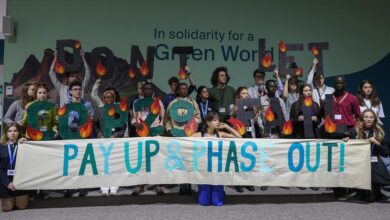The sixth storm this month made landfall in the Philippines

A potentially catastrophic super typhoon has made landfall in the Philippines – the sixth storm to hit the country in a month.
The state forecaster said Man-Yi, known locally as Pepito, hit the ground at 9:40 p.m. local time (13:40 GMT) with maximum sustained winds of 195 km/h (121 mph) ) along the east coast of Catanduanes Island.
The agency warned of a “life-threatening storm surge”, heavy rain and fierce winds, and hundreds of thousands of people were evacuated ahead of the storm’s arrival.
At least 160 people are known to have died in five previous storms.
BBC Weather reported that super typhoon Man-Yi is expected to have widespread impact.
There will be widespread heavy rain in northern areas, with more than 300mm (11 inches) expected to fall on Saturday and Sunday – leading to potential flooding and increasing the risk of landslides.
Winds of up to 270km/h are expected as well as waves of up to 15m (49ft) in east coastal areas.
The capital Manila was able to avoid the worst of the winds as the storm moved north, before crossing Luzon – the largest and most populous island in the Philippines – and heading offshore on Monday.
According to local television station ABS-CBN News, dozens of flights were canceled due to the approaching storm.
The civil defense agency said more than 400,000 people had followed evacuation orders ahead of the storm. The agency’s head, Ariel Nepomuceno, urged everyone living in the storm’s projected path to comply with these orders.
“It is now more dangerous for people in landslide-prone areas because the ground has been saturated successively,” Mr. Nepomuceno said.
Glenda Llamas was among those forced to leave their homes.
“We are very afraid of the storm because it could strengthen and the water could rise,” she told AFP news agency from a shelter in the eastern province of Albay.
“If we don’t evacuate, we won’t be able to go out later, we don’t have anyone else in the house but us.”
Melchor Bilay, who was evacuated to a school further south, in Sorsogon province, said: “We had a lot of phobias due to previous natural disasters that happened here like floods, wind natural disasters and other disasters”.
 EPA
EPAAlthough typhoons are not uncommon in the Philippines, forecasters said it is unusual to see so many tropical storms in the Pacific at the same time in November.
Tropical Storm Trami dumped a month’s worth of rain on large areas of the northern Philippines in late October, killing dozens of people.
Next was storm Kong-rey, which killed at least 3 people. That is also The biggest storm directly hit Taiwan for nearly 30 years.
Typhoon Yinxing impacted northern Luzon island earlier this month, where it brought nearly 250mm (10in) of rain in some areas.
Since then there has been Typhoon Toraji and earlier this week Typhoon Usagi, which brought storm surges of 3m and torrential rain in excess of 200mm (8 inches).
The United Nations climate change agency, the IPCC, said that although the number of tropical cyclones occurring globally is unlikely to increase due to planetary warnings, it is “very likely” that they will Rainfall is higher and reaches higher peaks. wind speed.
This means that a higher proportion will reach the highest intensity categories.





